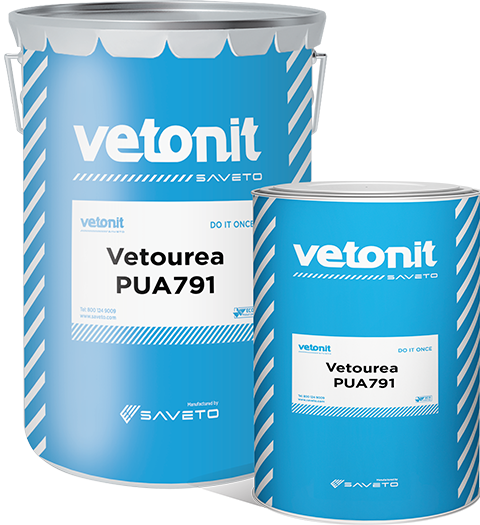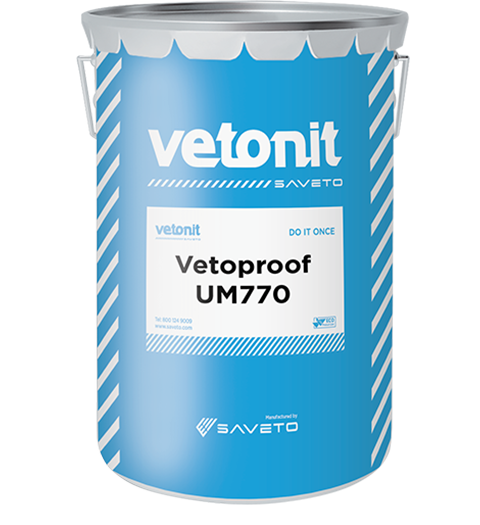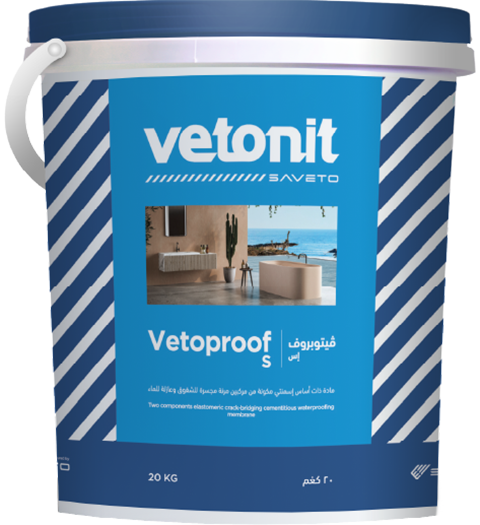Vetourea PUA791
Two-component, solvent-free, cold brush-applied, flexible polyurea waterproofing membrane.
<p>Vetourea PUA791 is a two-component, cold brush-applied, solvent-free, low-odor, high-performance, slow-curing, and flexible polyurea waterproofing membrane. It can be applied in virtually any environmental conditions without negatively impacting curing time or physical performance. It provides a seamless and durable substrate protection solution.</p>

Uses
- Substrate protection for plant rooms and trafficable roof decks.
- Waterproofing for areas exposed to high wind abrasion.
- Waterproofing of water features, pools, ponds, bridges, streets, and tunnels with high residual moisture.
- Lining of non-potable water and wastewater tanks.
- Loading docks and access ramps.
Advantages
- Solvent-free.
- Low VOC content.
- Very good hiding power when pigmented.
- Stable over a wide temperature range.
- Extended service life duration.
- High flexibility and impact resistance compared to traditional epoxy systems.
- Can be applied even under extreme climatic conditions: hot, cold, and humid.
- Excellent adhesion to concrete, steel, aluminum, plastics, fibers, wood, foam, etc.
- Longer open times, making it ideal for hot and humid climates.
Usage Instructions
All new concrete surfaces must be cured for at least 28 days prior to the application of the primer. All cementitious substrates must be structurally sound.
For previously painted surfaces, remove old paint completely. The substrate should have sufficient strength and be free from unsound areas, pug holes, protrusions, and pops. Make sure that the surface is clean, dry, and free from dust, oil, grease, salt, mold, and all forms of release agents/curing agents. A light sanding with suitable abrasive material is recommended before application. Any resulting dust or loose particles must be removed before application.
All surfaces receiving Vetourea PUA791 should be primed with Vetoprime EP491, designed for maximum absorption and adhesion to concrete substrates. Add the entire contents of the hardener tin to the base tin and mix the two primer components thoroughly for at least 3 minutes - only mix full packs. Once mixed, the primer should be applied immediately to the prepared substrate using stiff brushes and/or rollers. The primer should be well ‘scrubbed’ into the substrate to ensure full coverage. Take care to avoid over-application or ‘ponding.’ Allow the primer to dry before proceeding to the next stage. Do not proceed while the primer is ‘tacky,’ as this will lead to unsightly marks on the finished surface. Porous substrates may require a second primer coat when the first coat is directly absorbed into the substrate but observe a minimum over-coating time.
Vetourea PUA791 is supplied in two pre-weighed packs (base and hardener), ready for immediate on-site use. Part mixing of these components is not acceptable and will affect both the performance and appearance of the finished floor. Mixing should be carried out using either a forced action mixer or a heavy-duty mobile mixer fitted with a jiffy-type mixing paddle. All such equipment should be of a type and capacity approved by Saveto. The components should be mixed in a suitably sized mixing vessel. Stir the base and hardener components individually, then empty them into the mixing vessel, scraping the edges, and mix for 3-4 minutes until a completely homogeneous material is obtained.
Vetourea PUA791 can be applied using a brush, roller, or airless spray machine.
When applying two or more coats, allow each coat to dry completely before applying subsequent coats. The waiting time between coats is a minimum of 6 hours and a maximum of 24 hours. If the recoat window is exceeded, sand slightly to produce a profile, wipe with acetone, and then apply the next coat. When applying Vetourea PUA790 with a squeegee or notched trowel, the floor should be back rolled using a spiked roller to assist in de-airing the coating.
Remove Vetourea PUA791 product from tools, equipment, and mixers with Vetonit Solvent XX400 immediately after use. Cured material can only be removed mechanically.








